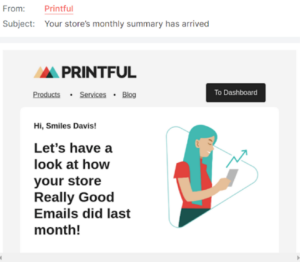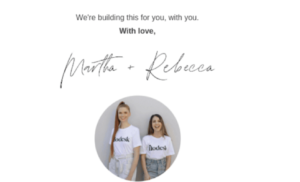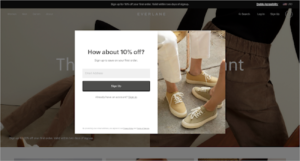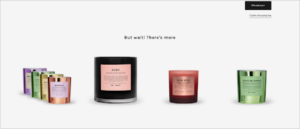The Marketer's Guide to
Navigating Economic
Headwinds
Intro
After years of economic uncertainty brought on by COVID, market downturns, and persistent inflation, many brands were hoping for smoother waters ahead. Yet, key barometers measuring the health of the economy forecast recessionary warning signs for the foreseeable future. Navigating these economic headwinds will prove to be a major concern for businesses as they look to protect against potential risks by cutting their spending and reducing overhead. As many marketers know, this often means an executive-level desire to slash budgets within their own departments. While this strategy can often lead to short-term benefits in marketing ROI, it leaves brands in the unenviable position of negatively impacting their long-term profitability and brand recognition within the marketplace.
Instead of looking for ways to reduce marketing spend, the most successful companies invest in strategies that focus on cultivating more effective, consumer-focused marketing without bogging internal teams down with additional work. When the market inevitably begins to rebound, the brands that continued conversations and maintained brand awareness with their most valued customers throughout 2023 will have a tremendous leg up on their competition. In this guide, we lay out the most effective, time-proven strategies that any business can follow to navigate economic headwinds and continue to drive ROI.
Don't Make Assumptions About Your Customers
One of the biggest mistakes marketing teams can make right now is to make assumptions about how their customers may act during a time of economic uncertainty. Consumer behavior is not a foregone conclusion, and spending habits can change on a dime. We saw this multiple times during the onset of COVID-19. Factors such as how often your customers will shop, how much they’re looking to spend, what products they’re interested in, and what platforms they’re most commonly using to make buying decisions should be assessed using hard data. In order to do this, make sure you’re working with an effective, low-lift customer data platform (CDP) that can give you insights into your customers’ actions across all touchpoints leading to a sale. With these insights, you’ll be able to create hyper-granular marketing touchpoints through content that speaks directly to their online behaviors and individual interests.
Be conscious of what CDP you use, though, as not all platforms are created equal. In fact, research suggests that only 10% of marketers feel like they’re current CDP is meeting all of their needs. Take a look at the key considerations you need to keep in mind when launching effective, CDP-backed marketing campaigns.
Understanding Consumers & Personalizing Campaigns with a CDP
What is a CDP & Why is it Important?
In simplest terms, a customer data platform (CDP) is software that centralizes and unifies an organization’s first-party data collected and aggregated from multiple sources. The goal is a single, comprehensive view of every customer and their relationship with your brand. It creates a comprehensive customer database accessible to and from other systems to store, analyze, and orchestrate customer interactions.
There are several business reasons an organization may choose to implement a CDP. The following are a few of the most common business drivers.
 Centralize an organization’s first-party customer data.
Centralize an organization’s first-party customer data.Many of the systems that marketers use operate in silos without the ability to share data back and forth. By centralizing that data in a CDP environment, marketers gain a complete view of the customer relationship to drive better decision making – a single source of truth for first-party customer data.
 Manage the integrity of first-party customer data.
Manage the integrity of first-party customer data.CDPs give marketers the ability to control data flow between systems and automate processes designed to integrate and cleanse data, while also operationalizing many of the steps necessary to manage consent and compliance.
 Activate first-party customer data in market.
Activate first-party customer data in market.Once first-party data is centralized in a CDP and organized into customer profiles, it is available and optimized for activation in marketing programs and across channels.
 Gain insight into audiences and customer behavior.
Gain insight into audiences and customer behavior.What type of data comprises a CDP?
Customer data platforms manage first-party data—that is data collected by a brand or organization over the course of customer engagement and interactions. As a rule, organizations should know exactly where, when, and how first-party customer data is collected.
Examples of first-party customer data include demographics, website activity, online and social behavior, transactions, email engagement, customer service and sales interactions, customer feedback programs, purchase history, and inferred interests.
By contrast, third-party data is purchased data or data that is shared from other businesses. Zeta’s CDP offering is unique in that it provides seamless integration with the Zeta Data Cloud, a proprietary third-party solution comprising 225M+ consumer profiles and billions of purchase and transaction signals. From improving personalization with additional customer insights to targeting prospect audiences for new customer acquisition, the Zeta Data Cloud can exponentially increase the efficacy of your first-party data for marketing.
Can a CDP replace the need for a CRM?
A CDP should not be thought of as a replacement or an alternative to a customer relationship management solution. Rather, they share a symbiotic relationship. A CDP collects, unifies, and centralizes first-party customer data from multiple sources and creates a single source of truth that is made available to marketing systems in real time. CRM solutions enable businesses to manage customer relationships and interactions with prospects and consumers, all while supporting a rather rigid predefined data structure. Ideally, because a CRM is part of the martech stack, the CDP and CRM should work in concert with each other within the same marketing ecosystem.
At Zeta, we see the relationship between the CDP and CRM solution as critical. That’s why our Zeta Marketing Platform features an embedded CDP at its core, ensuring that accurate and enriched customer data is available in real time for activation via the ZMP’s customer relationship management capabilities—all coming together to create orchestrated, personalized campaigns and offers across channels.
Diversify Your Marketing Efforts: Programmatic & CTV
Once you’re able to better recognize your customers to help create more individualized marketing campaigns, you’ll be ready to start targeting and interacting with them online. During times of economic uncertainty, it’s important to not make assumptions about which channels or platforms will be most effective in reaching your target audience and driving new sales. To combat this, try running campaigns that can be channel and platform agnostic, breaching the walled gardens created by many popular social and search giants. Look for a marketing partner that can help you run campaigns to reach consumers wherever they go online. In this section, we’ll discuss the best ways for any marketer to do this across programmatic and CTV.

Programmatic
Programmatic advertising (automated bidding on ad inventory in real time for the opportunity to show an ad to a specific customer, in a specific context) is one of the key digital investments every marketer must consider. In fact, programmatic spend is projected to increase nearly 20% this year—resulting in an additional $70 billion invested into the strategy. Programmatic advertising simply means serving ads that are targeted to consumers in real time based on their online behavior—reaching them on publisher sites, social media platforms, and across channels like CTV.
Focus Your Efforts on Retention & Acquisition
It costs more than money to acquire customers—it costs time, energy, and talent.
The cumulative cost of acquisition is especially high (sometimes as much as 10x higher) when compared to the total cost of customer retention.
This disparity explains why smart, successful companies that are built for longevity make customer retention a bigger focus than new customer acquisition. The best way for marketers to do this is to leverage hyper-individualized personalization in their campaigns. Competition for consumer dollars will likely be fierce throughout the year as people tighten their wallets. Do not run the risk of ostracizing any potential customers by serving them ads that have nothing to do with their interests or online behaviors. Customers want to be loyal to brands that are loyal to them, so prove this by showing you care about their marketing experiences.
Even though retention should eclipse acquisition in the way of importance, customer acquisition will always be a primary objective for any marketing executive. Therefore, keeping the cost of acquisition as low as possible is critical.
To that end, marketers and the brands they work for must know how to execute omnichannel as a tool for lowering customer acquisition costs. Omnichannel makes it possible to maximize prospect data across channels to take advantage of every touchpoint along the customer journey.
Here are a few keys to effective omnichannel activation:
- You need good data
Any information you have on prospects (be it known or unknown data) should be enriched and used to engage in AI-modeling. To be successful in terms of obtaining actionable insights about individual customers requires a strong ability to identify individual prospects and their behavior through deterministic attribution. You need good data strategies
To thrive with omnichannel acquisition, you not only need high-quality data, but you need intelligent strategies for using that data. Effective strategies can be built using a number of approaches including geo-fencing, lookalike modeling, and the effective use of customer segmentation.
You need to activate in the right channels
Everything starts with your company’s website—if this isn’t buttoned up, your omnichannel acquisition process will never, ever take flight. That means you can’t have any breaks in your on-site conversion path, and—if you do— you must be able to re-engage prospects during their onsite visit to complete their conversion.

Create Effective Re-engagement Strategies
To drive new sales for new and returning customers, it’s important to ensure you’re re-engaging and cross selling your audience. Before you do so, make sure you know the distinction between an active and inactive customer. In other words, you need to create clear criteria for each classification of customer. Doing so will make it easier to develop and deploy different strategies that cater to each audience. With active customers, those strategies will center around light engagement across carefully selected channels. With inactive customers, those strategies will incorporate heavier engagement that’s targeted at specific types of individuals (e.g. one-time shoppers) using particular channels.
Utilize great data, such as the below, to understand how active consumers are with your brand.
- Offline behavior
- Customer transaction history
- One-time customers from repeat customers
- Customers with high lifetime value versus those with low lifetime value
Once you’ve collected and collated your data, you’ll need to enrich it with additional signals—geographic signals, behavioral signals, etc.
CTV
While most marketers are already taking advantage of their programmatic efforts across display channels, the point of ensuring you’re creating the most effective marketing campaigns during an economic downturn is to diversify your efforts. In order to do so, consider adding connected TV (CTV) as a channel in your marketing efforts. CTV is no longer the future, it’s here. In fact, a whopping 92% of American households are reachable on this platform. Here are a few more reasons to add CTV to your 2023 plans:
- Linear TV is on the way OUT and Connected TV is on the way IN.
Slowly but surely, streaming TV is passing linear—it’s a legacy form of entertainment that’s struggling to remain relevant—and as viewers continue to cut the cord, broadcast TV will cease to be as effective at influencing large audiences of consumers.
CTV offers personalized targeting
Personalized targeting (advertising that targets specific households as opposed to large, general audiences) isn’t possible through linear TV, but it is possible with Connected TV. With CTV, marketers can utilize high-value, people-based data signals to deliver scalable, personalized advertising.
CTV offers real-time marketing opportunities
The programmatic nature of Connected TV makes it possible to match quality supply with demand in real time (as opposed to linear TV where supply is not sold at auction in real time, but is sold months in advance on a CPM basis).
CTV costs are comparatively cheap
The CPMs for Connected TV are far lower than they are with linear TV—that means if marketers start moving away from linear and towards connected, they’ll be able to harness the power of TV advertising without devoting the big “chunk” of budget that traditional broadcast advertising requires.
Zeta’s Programmatic Difference
These strategies should serve as a baseline for brands looking to create effective online marketing campaigns, but they’re certainly not exhaustive. To drive the most programmatic success, brands should work with a world-class programmatic partner. The Zeta Marketing Platform uses AI and machine learning to make real-time programmatic decisions based on audience definitions developed using interest and intent signals pulled from the Zeta Data Cloud (e.g., people interested in luxury fashion). In other words, Zeta’s approach to programmatic ensures your media dollars aren’t wasted and your programmatic bids are priced dynamically.
At Zeta, we “market in the moment” when it comes to programmatic, which means we can more efficiently find the individuals most likely to convert on your campaigns.
Zeta’s approach to programmatic analyzes thousands of attributes (e.g. time of day, site activity, device) to learn which consumer actions matter most. This predictive technology can then be used to create a simple visual showing campaign performance improvements to better understand the most influential moments among customers.
Leveraging the
Power of Email
Programmatic will prove to be an effective strategy for marketers looking to make the most out of their 2023 efforts, but it should not be utilized in a vacuum. The most effective marketing campaigns will combine programmatic with other channels like email—one of the most popular and effective marketing channels of all time with a much higher average ROI per dollar spent than other marketing channels.
Email might not be as shiny and novel as paid ads and social media, but it is arguably the most powerful and cost-effective way to use an owned channel to drive business results.
With the average person receiving over 120 emails each day, standing out is harder than ever. That’s why Zeta went to ask real email experts to help marketers make the most of their email marketing campaigns with highly effective, personalized campaigns.
So why is personalization in email so important? Saving money isn’t the only benefit; it can also help:
- Improve open rates through personalized subject headings.
- Reduce unsubscribes by sending more relevant emails.
- Increase conversions by suggesting relevant products/services.
- Build better relationships with prospects and customers.
We have curated the best insights from Zeta’s email experts to share their time-proven tips and tricks on how to create engaging, revenue-driving campaigns that are personalized to each customer.
1. Target customer personas
Not all customers are the same—they may be in various locations, have different interests, or even prefer to be emailed at night versus the morning.
Send more relevant emails by separating your customers into segments based on personas. Say your business sells both children’s and adult clothing. Segmenting users based on personas means only those who purchase children’s clothing see offers for a new kid’s line.
2. Use personalized subject lines and emails
Believe it or not, just adding the customer’s name in the email body can increase open rates by up to 35 percent.
While many organizations add the “name” tag in the body of the email, consider adding it to your subject lines as well. And don’t be afraid to take it beyond the name tag. Messages can leverage other personal information such as industry, past purchases, or location. This example mentions the user’s store in the subject line and their name in the body of the email:

3. Use behavior-triggered emails
Automated, behavior-based emails save marketers time and deliver hyper-relevant messages when users need it most. In addition to increasing open rates (because emails are relevant), triggered messages improve customer service and retention.
Set triggers to welcome new subscribers, recover abandoned carts, upsell, encourage reviews, or re-engage users who haven’t opened emails recently. Trigger emails can also be set to remind users to replace a consumable item, ask for referrals, or send educational resources.
4. Segment customers based on their onsite actions
Label specific users based on information you’ve gathered on their onsite behavior. Then, leverage this to create targeted campaigns. For example, a business could tag users that visit specific category pages and later send them an email based on new product launches or discounts within that specific category.
Other examples include segmenting consumers based on pages they visit, purchases, location, industry, or interest in a specific type of product or service.
5. Add an email signature
An email signature is a short, personalized ending to an email that tells the sender who you are. The most obvious benefit of adding a signature is to make the email seem more personalized, like it is coming from a person rather than a large, anonymous corporation.
Adding a personalized signature can boost brand awareness, increase trust, and help build social media followers. Depending on organizational structure and the purpose of the email, the signature could be from your customer success representatives, your marketing leadership, a brand ambassador, and so forth.

6. Add “recommendations for you”
Looking to increase upsells and engagement? Rather than sending every subscriber the same recommended products, send targeted emails based on past interactions or purchases. This is a common strategy for eCommerce, but it works well for content and service-based businesses as well.
7. Add a sense of urgency
Creating a sense of urgency in messages is a simple strategy that increases CTR and can drive subscribers to act. Pairing time-sensitive terms and dates with personalization compels users to take action now.
For example, “[Name], this deal expires in 24 hours” incites the user to act more urgently.Other time-sensitive words include:
- While supplies last
- Sale ending soon
- Limited time offer
- In-store only
- Don’t miss
8. Use and optimize landing pages
Email personalization goes beyond email messages—your landing pages also impact the effectiveness of email campaigns. Start by optimizing landing pages to ensure they load fast, use benefit-focused headings, and include a CTA above the fold.
Then, add personalization to landing pages by incorporating dynamic landing page content that adapts to each user’s profile and where they are in the buying cycle. This might include using their name, mentioning the company they work for, or simply offering content on topics they’ve previously engaged with.
Drive a 766% Lift in Email CTR with Zeta
Let’s look at a campaign where personalization helped the brand drive its email performance.
A travel destination marketing organization (DMO) approached Zeta as they wanted to leverage data to create a better experience for their audience. They were in the process of collecting data, but it only covered a fraction of their audience.
By working with Zeta, we were able to help the brand identify all site visitors (known and anonymous). We also placed tags on their website at the category and article level. This enabled us to capture browsing data showing the categories and products that an individual is interested in.
We didn’t stop there. We tapped into Zeta’s Data Cloud, which unlocks behavioral interests, transactions, and location visits at the individual level for well over 225M people in the US. These insights covered 97% of their subscribers, providing insight into what their audience was doing outside the brand.

Our strategy led to impressive results:
- 162% lift in open rates and 766% lift in click-through-rates when targeting an audience with data-driven personalization in email, compared to non-targeted, batch-and-blast emails.
- 27%+ lift in out-of-state subscribers taking a trip who received a personalized email, vs. non-personalized batch-and-blast emails.
Understanding who your customers are and what motivates them is what allows you to build a relationship and generate action. It enables you to migrate away from a generalized batch-and-blast approach to become hyper-individualized in your communication. Talking to them, not at them, can make all the difference in your comms strategy.
Marketing Through the Funnel: Onsite Personalization
Marketing isn’t Done When Consumers Come to your Page
Successful Website Personalization Strategies
As mentioned above, optimizing and personalizing your onsite experience can be just as critical as your off-page marketing efforts, and is pivotal to ensuring that you’re engaging with customers all the way through the point of sale. To make the most of your marketing efforts, here are a few key onsite strategies to employ:
Overlay
These are interactions above a website in pop-up form. Overlays provide flexible creation options and support various stages of the customer journey and business use cases. A great example of this can be seen below, which uses an overlay to offer new customers 10% off their first purchase if they provide an email address.

In-page
Better known as onsite recommendations, these are in-line offerings such as “you may be interested in.” These are typically a predefined size and placed in a specific position on page (e.g. when viewing a cart).

Site optimization
This feature is integrated with the structure of your website and organizes content on parts of the page to personalize the experience. This feature allows for custom integrations but requires heavier implementation.
Landing page optimization
These are custom landing pages meant to drive traffic and are optimized based on conversion metrics (toward best converting). Similar to site optimization, landing page optimization allows for custom templates but requires heavier implementation.
Here are a few key strategies for some of the most common website personalization strategies for overlays, in-page, and onsite recommendations:
Overlay use cases
The number one use case for overlays is acquiring new customers. This can be done through things like lead generation (quote requests and scheduling a consultation/visit) and promotions (discounts and sales, or personalized messaging tied to paid media).
Another use case for overlays is to drive conversion or avoid abandonment. Use product recommendations with a variation of sizes, colors, and styles, as well as related products to grab attention. Moreso, implement incentivized messaging such as alternate styles/sizes, promotional discounts, or a countdown clock. Be sure to interact at the point of abandonment and re-engage on revisit for the best customer experience.
Lastly, overlays can be used to increase retention. Prompt returning customers to review or rate their last purchases, implement an onsite chat, and facilitate in-store returns. These strategies are all proven ways to encourage repeat purchases and drive lifetime value.
In-page / Onsite Recommendation use cases
In-page features are best used for product recommendations and content recommendations.
For product recommendations, consider leveraging promotional discounts and be sure to show a variation in sizes, colors, styles, locations, and categories (i.e. Recommended For You’).
Personalized offers are also a great in-page tactic, and Zeta’s AI can determine the optimal product selection for each customer. In general, 70% of companies that use personalization involving AI see a 200% ROI or more.
The benefits of working with Zeta for website personalization
Zeta website personalization tracks individuals’ real-time activity on your website and enables rich personalization to boost conversion, increase order value, and enhance the overall customer experience. With our wide range of features, you can…
Uncover real-time insights of each consumer on your website
Through accumulated website activity on the individual level, you can continuously enrich data to enable 1:1 personalization on your website.
- Track each customer’s real-time website activity, including products of interest, levels of engagement, conversion history, etc.
- Tie onsite activity to signals from offline CRM data to create a holistic customer view.
Scale your personalized interactions and content for each consumer
Create personalized experiences with content and messaging that reflects a consumer’s real-time interests.
- Target consumers based on their website activity and other signals.
- Personalize messaging, including interactions and in-line content based on any attribute.
- Encourage engagement by presenting relevant offers for each stage of the customer lifecycle.
Measurement & Optimization
Marketers are sitting between a rock and hard place. Traditional performance metrics like clicks and impressions are quickly losing significance because they don’t speak to tangible business metrics, like ROI and impact on the bottom line. However, these higher value metrics are often difficult to obtain, organize, and understand. As a result, getting budgets approved is becoming more difficult by the day. CFOs want evidence that marketing spend will create value for the company before making a financial commitment. But there’s a solution most marketers overlook: deterministic measurement.

Deterministic measurement rooted in always-on incrementality
Deterministic measurement is a vendor’s ability to constantly monitor and appropriately allocate budget to high-performing, high-ROI campaigns. It’s rooted in incrementality and measurement, and is how you go about obtaining the true results of any marketing initiative you run. Using incrementality measurement, a marketer can determine the exact influence (i.e., the incremental benefit) in achieving their desired business outcome (e.g., more revenue). It measures the true lift of your campaign against your stated goals.
Put another way, incrementality matters because it replaces ancillary forms of measurement such as media mix modeling, attribution measurement, and panel-based measurement.
But incrementality is hard to do well. Most marketers eat hidden costs when it comes to incremental measurement, such as costs associated with control groups. Imagine you have a group of 100 ideal prospects. However, for the sake of incrementally evaluating your campaign, you withhold 10 of those prospects as a control group. That’s 10 ideal engagements that you’re sacrificing for the sake of your test. In this scenario, you’re eating a 10% opportunity cost because only 90% of your ideal prospects will see your marketing (rather than 100%). Put another way, you’re losing $0.10 on every potential dollar just to measure the true effectiveness of your campaign—that’s a steep price to pay for an experiment.
Deterministic measurement capabilities, like in Zeta’s TruLift, don’t require an expensive holdout group to provide accurate lift measurement – helping you avoid wasting dollars.
Don't Limit Your Marketing to Just One Platform or Channel
2023 is shaping up to be another rollercoaster year for brands as uncertainty around the stock market, the debt ceiling, and consumer sentiment continue to loom. However, this environment can provide more opportunities than headwinds for businesses who are willing to pivot their strategies and focus their energies on targeting individual consumers with highly individualized, channel-agnostic marketing campaigns. If you’re unsure where to start, reach out to an expert at Zeta today.
